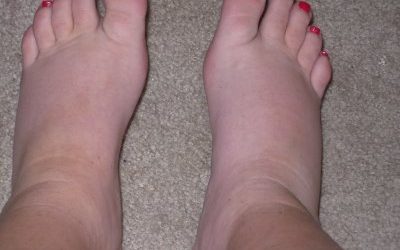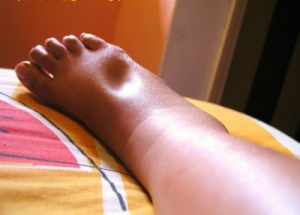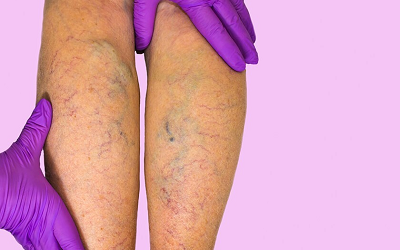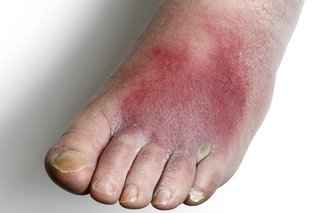Swollen Top Of Foot, Ankle: Any Pain? 10 Causes, Treatment

Last updated on July 26th, 2018 at 04:34 pm
Question: What causes the swollen top of foot? How can I quickly relieve swelling and pain on top of the foot?
In 2015, in the United States, 630,000 deaths were recorded from heart disease. This means, one in four deaths happen because of heart-related problems.
One common symptom of heart disease is swelling at the top of the foot which may sometimes involve your ankles and legs. In severe cases, swelling (edema) may extend to the abdomen.
Heart failure is a phenomenon where the heart does not function optimally and is not capable of supplying the much-needed oxygen, blood, and nutrients to your tissues. If this happens, fluid slowly builds in the dependent areas of your body, and usually, swelling is located at your legs, foot, and ankles.
Other serious causes of top of foot swelling are diabetes, lymphedema, kidney failure, venous insufficiency, and chronic liver disease.
Also, if you feel pain and swelling in your foot, its likely due to osteoarthritis, gout, ankle sprain, tendonitis, cellulitis, or a fracture is severe cases.
But don’t panic. It is possible to have intermittent foot swelling that comes and goes. This could be due to standing up for long hours and is noticed in the evening, or at night. Other causes are dehydration, weak veins, and obesity.
When to see a doctor?
There are multiple reasons you may develop foot swelling, and in reality, its difficult for you to diagnose on your own. Therefore, it is important you inform your doctor about your concerns. Here are some questions to expect.
- When did you notice swelling of your foot?
- Is it painful or not?
- Do you have swelling on one foot or both?
- Any difficulty in breathing, orthopnea, or sudden waking up at night and gasping for breath?
- Any injury or accident before foot swelling?
- What relieves swelling of the foot?
- What makes swelling worse?
This article explains the causes of pain and swelling on top of foot, and treatment options available.
What causes swollen top of foot no pain?
If you are experiencing swelling at the top of the foot without pain, you may not be utterly concerned. The truth is, the absence of pain does not make your illness trivial. It is important to see your doctor ASAP. Here are the common reasons you have painless swollen feet.
1. Heart failure
Physiologically, your heart pumps blood to your body tissues for metabolism. This is made possible by the contraction of your heart muscle.
During heart failure, the heart’s ability to pump blood diminishes causing blood to pool at your lower extremities.
What causes the heart to fail?
Heart failure can result from cardiomyopathy (weakened muscle), high blood pressure, damaged heart valves that control blood movement in the heart, coronary artery disease, Diabetes Mellitus, and abnormal thyroid.
What symptoms will I experience?
Foot swelling due to heart failure is bilateral, meaning, it affects both legs. Other symptoms are central chest pain, difficulty in breathing especially on activity, leg swelling, increase voiding at night, cough, and fatigue.
If you have these symptoms, it is likely your heart is failing. Talk to your doctor
Is there treatment for a failing heart?
Because there are multiple causes of heart failure, treatment will depend on the cause. So, after informing your doctor, he will request some investigations to be carried out. They include blood and urine tests, lipid profile, ECG, Echocardiography, chest x-ray, and an MRI.
Treatment involves the use of drugs that help improves contractility of your heart muscles and diuretics. Diuretics are medications used to stop foot swelling by removing excess water stored in your body. In severe cases, surgery will be required.
2. Kidney disease
The kidneys are small bean-shaped structures at your flanks that help in electrolyte balance and removal of waste product as urine.
If the kidneys fail to remove waste products, you will develop swelling of your foot.
What causes kidney failure?
Kidney failure is caused by
- Direct trauma to one or both of your kidneys
- Chemotherapy medications
- Antibiotics use
- Low kidney blood supply
- Obstruction of the urinary tract
- Abnormally shaped cystic kidneys (polycystic kidney disease)
What are the symptoms of kidney failure
Aside from swelling of the top of both foot and ankles that is worst in the morning, you may experience
- Increased frequency of urination in long-standing illness
- Decreased frequency of urination in an acute illness
- Vomiting
- Nausea
- A headache
- Difficulty in breathing
- Flank pain
- Back pain
- Loss of appetite
- Swelling of the eyes, face, and hands
How to treat kidney failure?
If your kidneys are failing, you will need urgent dialysis. In chronic damage kidneys, your doctor will request a kidney transplant.
3. Liver failure
Another reason for a painless top of foot swelling is liver failure. Liver failure means your liver cannot perform its metabolic functions, and in severe cases, protein in blood drops. This allows accumulation of fluid in your abdomen and foot.
Other symptoms of liver disease are yellowness of the eyes, swollen abdomen, bleeding, dark urine, nausea, and fatigue. Talk to your doctor if you have these symptoms.
4. Pregnancy
 For pregnant women, top of foot swelling can happen, and it is entirely normal. During pregnancy, foot swelling occurs due to increased body fluid that is necessary to nurture both the mother and the baby. Swelling is painless and could extend to your ankle and leg.
For pregnant women, top of foot swelling can happen, and it is entirely normal. During pregnancy, foot swelling occurs due to increased body fluid that is necessary to nurture both the mother and the baby. Swelling is painless and could extend to your ankle and leg.
Swelling during pregnancy is physiologic, and there is no reason to panic. After delivery of the baby, foot swelling will disappear. However, generalized body swelling during pregnancy affecting the face, hands, and foot may be a sign of preeclampsia.
What causes top of foot swelling and pain?
if you are experiencing swelling of the top of the foot with pains, here are the possible causes
1. Enlarged superficial varicose veins
Varicose veins are enlarged dilated veins commonly affecting the lower extremities. They result from damaged valves that cause pooling of blood in your legs and ankle. This results in ankle and foot swelling.
After a long walk or standing for a long time, a varicose vein may cause you to feel cramps at your legs. To prevent this from happening, you can elevate your legs or use compression stockings.
2. Gout
 Gout is the medical condition that occurs when your body builds up urate crystals and deposits them at your joints. Any joint in your body can be affected. However, the most commonly affected joint is the big toe.
Gout is the medical condition that occurs when your body builds up urate crystals and deposits them at your joints. Any joint in your body can be affected. However, the most commonly affected joint is the big toe.
Physiologically, purines are broken down to uric acid that can be excreted through the kidneys. If there is excessive production of uric acid or impaired functions of your kidneys, it can cause the build-up of uric acid level causing Gout.
Symptoms of Gout are
- Excruciating pain at the base of your big toe
- Reduced movement of the foot
- Decreased flexibility of big toe joint
What to do?
If you have intense pain and swelling of the top of foot, especially at the base of the big toe, it could be Gout. See your doctor for help.
Investigations are usually requested, and they include an x-ray of your foot, serum uric acid level, and test to asses kidney function.
Treatment involves the use of colchicine, Ibuprofen, Naproxen and oral prednisolone (a steroid).
3. Osteoarthritis
Osteoarthritis is bone pain and inflammation that happens mainly in the elderly. You may also feel swelling of the ankle and foot with decreased joint flexibility.
4. Cellulitis
Cellulitis means an infection that affects your skin. Symptoms are foot pain, swelling, redness, and tenderness when walking. Talk to your doctor if you have these symptoms.
